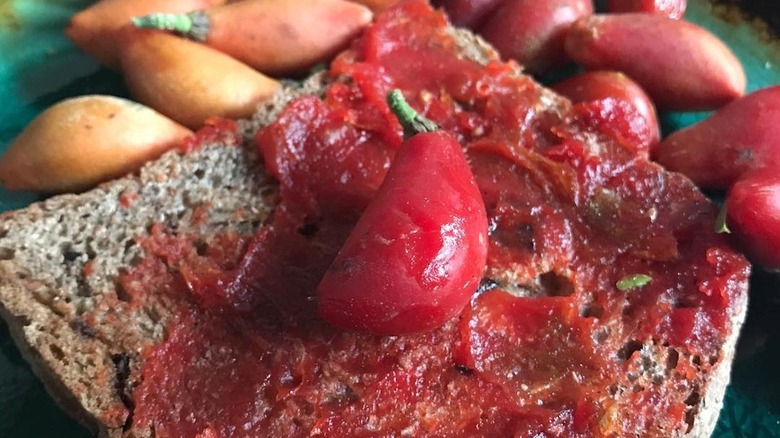The South American Fruit That Tastes Just Like A PB&J
A PB&J without the bread ... or peanut butter ... or jelly? Dreams can and do come true, sometimes in the form of fresh produce. Behold, the peanut butter fruit (Bunchosia argentea)! Native to the Amazon rainforest region of South America, this tiny-but-mighty scrumdiddlyumptious gem belongs to the Malpighiaceae plant family and is commonly harvested in countries like Brazil, Colombia, and Peru. The peanut butter fruit grows on small evergreen trees or bushes, growing in clusters of fruits that start off pale green and turn red once they're ripe.
This incredibly unique fruit, as you've probably guessed, gets its name from its distinct flavor, which resembles peanut butter. The small, round fruit typically measures less than 3 centimeters and sports a bright, reddish-orange skin. Inside, the peanut butter fruit contains a thick, creamy, sticky flesh that is pale yellow in color, surrounding a pit similar to that of an olive.
If you're a fan of the iconic spread, take your taste buds on a journey that will leave you puzzled, satisfied, and downright delighted.
What does the peanut butter fruit taste like?
The peanut butter fruit has a unique combination of sweetness and tang, just like the universally beloved sandwich staple. The flesh has a smooth texture with a nutty undertone. Plenty of people have even described its flavor as similar to that of a sweet potato or a fig.
The unusual tropical fruit showcases a velvety mouthfeel reminiscent of avocado, while its flavor essence is a lovely surprise. As you take your first bite, you'll notice an unmistakable taste of peanut butter, lending a subtle nuttiness to the fruit. When fully ripe, the peanut butter fruit sports a creamy, buttery texture, and is complemented by hints of sweet caramel, offering a pleasing contrast. Some enthusiasts describe additional undertones of vanilla or coconut, which add depth and complexity to the overall taste. The sweetness creates a delectable harmony that sets this fruit apart from more conventional options.
How to eat the peanut butter fruit
Peanut butter fruit is typically eaten fresh and can be enjoyed as a standalone snack or dessert. Some folks prefer to eat it simply by cutting it open and scooping out the flesh with a spoon, relishing the buttery goodness straight from the source. However, peanut butter fruit is often deemed a versatile ingredient in culinary creations. It can be used to enhance smoothies, shakes, and fruit salads, adding a distinct nutty note to the mix. Some creative cooks incorporate the fruit into ice creams or sorbets, making indulgent frozen treats that showcase its creamy texture. In some regions, the peanut butter fruit is used to make jams, jellies, or preserves. It may also be used as a filling for pastries, cakes, and other desserts, infusing a peanut butter essence into baked goods.
As the fruit's popularity grows, chefs and food enthusiasts are likely to continue experimenting with innovative ways to incorporate peanut butter fruit into a variety of meals. Whether enjoyed fresh, blended, frozen, or in creative recipes, this tropical delicacy is sure to leave a lasting impression on those fortunate enough to savor its exceptional taste.
Where to buy the peanut butter fruit
So, where can you get your hands on this incredible fruit? Peanut butter fruit trees require full sun to grow, which is why hotter states like Florida, California, and Hawaii often have ideal climates. The peanut butter fruit is not widely available in mainstream grocery stores, especially outside of its native range in Central and South America. Due to its limited distribution and relatively lesser-known status, it can be challenging to find this fruit in regular supermarkets or fruit markets. If you're interested in trying the peanut butter fruit, your best chances of finding it would be in specialty fruit markets, tropical fruit nurseries, or local farmers' markets in regions where the fruit is grown. Miami Fruit, the popular tropical fruit subscription service, ships peanut butter fruit to customers on occasion.
If you're in the mood to travel, you may have luck finding the peanut butter fruit in its native countries, such as Brazil, Colombia, or Venezuela. If you're in a tropical region with more diverse fruit markets, you might inquire with sellers who import unique fruits from different parts of the world.
Nutritional information about the peanut butter fruit
In addition to its charming, nostalgia-inducing flavor, the South American peanut butter fruit is highly regarded for its nutritional value. It is rich in vitamin C, as well as minerals like iron and calcium. It is also a good source of dietary fiber and antioxidants. Tropical fruits, in general, often contain significant amounts of vitamin C, potassium, and fiber.
The South American peanut butter fruit is believed to have medicinal properties, as its anti-inflammatory and antioxidant effects can help boost the immune system. Some Brazilian healthcare professionals even believe peanut butter fruit is powerful enough to reduce the risk of prostate cancer.
Though relatively lesser-known and not widely available outside its native regions in Central and South America, the peanut butter fruit is a hidden gem for those fortunate enough to experience its wonder. Its distinct profile makes it a sought-after delicacy, leaving an indelible impression on those who have the pleasure of savoring it.




